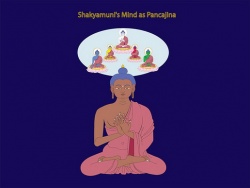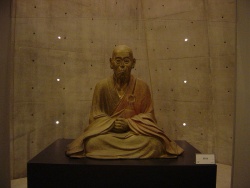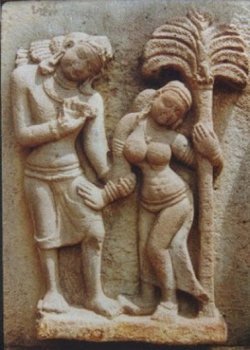Koshas: the State of the Mind
by Roar Bjonnes
According to the perennial philosophy of Tantra, the physical universe, the Body of the Great Chain of Being, is made up of five elements: ether, air, fire, water, and earth. These elemental concepts are also an integral part of Taoism as well as the Indian medical system, Ayurveda. P.R. Sarkar, using a more scholarly vocabulary, perhaps, refers to these five elements as the ethereal, aerial, luminous, liquid, and solid factors.
Since the human body is a microcosm of the macrocosmic body, it is also composed of these factors. In the human body, these five elements are regulated and controlled by prana (vital energy), which controls the vayus, or vital air's, which are responsible for such organs and activities as heart, lungs, excretion, circulation, etc. The individual elements are again linked to the different psycho-spiritual vortexes, or subtle energy centers, or chakras, located along the spinal column, through which the psycho-spiritual kundalini energy flows. Each chakra controls one of the various elements. Moreover, the chakras, which also are connected to the glandular endocrine system—which in turn is connected to the brain and thus the mind—are chiefly governed by five koshas, or states of mind.
In this brief description, many important details of the Tantric or Yogic approach to the Body-Mind are omitted. However, the detailed maps of this intricate and significant Body-Mind connection constitutes a subtle but real science, one which some scientists have begun to study with great interest. This multi-layered hierarchy of being, this intricate body-mind relationship—from cells to nerves, from body to brain, from mind to spirit—has been outlined in great detail over thousands of years by yogis and other spiritual mystics of many different traditions.
The basic premise of this gross and subtle body-science is that while aspiring toward inner, lasting bliss, we cannot ignore our physical health and existence in the here and now. Tantra views the body as the base in which the spiritual current needed for transcendence is grounded, and thus a healthy body is an indispensable means to reach higher realizations. In recent times, no one has documented this subject more comprehensively than Esalen founder Michael Murphy. In his path-breaking thesis The Future of the Body, based in part on the yogic insights of Indian mystic Aurobindo, Murphy describes the importance of an integrated spiritual practice, deeply rooted in a sophisticated understanding of the body-mind connection. Thus an integral body-mind practice may include a daily regimen of healthy diet (preferably vegetarian), sports (jogging, weightlifting, etc.), yoga, massage, tai chi, and meditation. As it is said in the Yoga Vasishtha, an ancient Sanskrit text: "For the ignorant person, this body is the source of endless suffering, but to the wise person, this body is the source of infinite delight."
As all genuine integral sages will point out, the entire creation itself is our Body. The body we walk in is made up of the same elemental stuff as the one beneath our feet. Again we witness the alchemical analogy: As above, so below. We are indeed the earth and our own body is therefore a partner in a great ecology of being that constitutes the environment we live in. From this perspective, a healthy mind in a healthy body means to also lead an environmentally responsible lifestyle. We have bitterly experienced in recent years, that when we pollute the Body of the Earth, we ultimately pollute our own body, as well.
The Mind-Spirit Connection
In the cosmic scheme of things, matter evolved from Consciousness. This view, that Consciousness creates the various elemental factors, which in turn materialize as matter, is unique to the perennial philosophy. In Tantra it is said that the five elements are created from the Cosmic Mind. This part of creation, which we may term "the spectrum of cosmic-ness," has yet to be clearly explained by modern cosmology or science. On the other hand, both the wisdom of Tantra and science agree that mind was created from matter. Tantra holds that because the entire mass of material structure has evolved out of the Cosmic Mind, the potentiality of mind will always remain latent in matter, and under the right conditions it will resurrect itself again.
Tantra sees mind as a latent part of all living cells. Where there is life, there is mind or cognition. This concept recently became part of science through the works of Humberto Maturana and Francisco Varela, who rediscovered, so to speak, that "living systems are cognitive systems, and living as a process is a process of cognition."
In its most basic form, mind exists on a cellular level, residing within the body as oil in a seed. Mind is thus expressed as the most primitive, cellular sensations and instincts, and as it evolves to the human level, its capabilities radically expand through repeated experience. The human mind, as a culmination of this evolution, expresses itself through instincts, emotions and rationality, and is thus capable of expressing everything from speech to logic, from creative imagery to spiritual bliss. The human mind, then, is a microcosmic potential or reflection of the Cosmic mind, or the Mind of God.
On our brief journey through the micro- and macro-cosmos, we have finally arrived at a crucial aspect within the Small Chain of Being, namely at the beginning stage of what Ken Wilber refers to as the "spectrum of consciousness." This concept concerns another universal feature of the perennial philosophy: the human mind can be divided into various levels, spheres or koshas. Sarkar notes that "the human being is composed of five layers of mind, just like the banana flower." The body, or annamaya kosha comprises the sixth layer. Each one of these "petals" envelopes the other and, depending on the perspective, progressively conceals or reveals the ultimate Brahma.
Similarly, in Vedanta Hinduism, an individual is composed of five such sheaths. First is the annamaya kosha, the physical body.
Second is the pranamaya kosha, or the sheath composed of life force; it is the connecting link between the physical body and the mind; the sphere of emotions.
Third, the manomaya kosha, is the rational mind. Next is the vijanamaya kosha, the sheath of intuition; the subtle mind.
Fifth is the anandamaya kosha, the sheath of blissful transcendence.
In Mahayana Buddhism, there are eight levels of consciousness. The first five represent the five senses. The next layer of the mind is based on sensory experience. The seventh layer, called manas, refers to both higher mind and the center of the illusion of the separate self. The final level is the alayavijnana, the veil before alaya or pure Spirit.
Sarkar emphasized the importance of understanding the essential nature of this spectrum of consciousness0—how the individual mind rests within and is part of the soul (atman). And, through an integral Body-Mind-Spirit practice, how the mind expands into this soul and finally, with its crystal-clear perception, unites with the Cosmic 0or Divine 0Soul.
Let us take a closer look at how Sarkar’s division of these sheaths expands on the Vedantic version by dividing the individual Body-Mind-Spirit into seven levels, including its many sub-functions:
1. Annamaya Kosha—the physical body, composed of the five fundamental factors or elements. Controlled by the crudest layer of mind, the kamamaya kosha.
2. Kamamaya Kosha—this state of mind is the "desire" kosha. Also known as conscious or crude mind. It has three functions:
a) sensing external stimuli from the outside world through the sense organs of the body,
b) having desires on the basis of those stimuli, and
c) acting to materialize those desires by using the motor organs.
This layer of the mind controls the motor organs and the instincts; it activates the body to satisfy the basic instincts of hunger, sleep, sex and fear.
3. Manomaya Kosha—the mental layer of mind. Also referred to as the subconscious or subtle mind. This state of mind controls the conscious mind. It has four functions:
a) memory,
b) rationality,
c) experience of pleasure and pain based on reactions from past deeds,
d) dreaming.
4. Atimanasa Kosha—the supra-mental or subtle mind, the layer of direct knowing, creative insight and extrasensory perception. Although most people spend the majority of their lives in the kamamaya and manomaya koshas, sometimes this layer is accessed through deep contemplation, artistic inspiration, or intellectual discovery. In this layer a deep yearning for, and sometimes an experience of, Spirit is felt.
5. Vijinamaya Kosha—the first layer of the causal mind, also called the "special knowledge" kosha. In this level of mind one is able to pierce through the veil of the gross, objective reality and get a glimpse of the world as it really is—simply Spirit. Many divine attributes are expressed through this state of mind: mercy, gentleness, serenity, non-attachment, steadiness, success, cheerfulness, spiritual bliss, humility, magnanimity and more. This kosha has two main functions: discrimination (viveka) and non-attachment. True discrimination means to be able to discern between Relative and Absolute truth. True non-attachment does not mean to escape the world but rather to embrace it as Spirit, to see that all is Divine.
6. Hiranamaya Kosha—subtle causal mind, also referred to as the "golden" kosha, because of its effulgent, blissful expression. Here the feeling of "I" is only latent, only a thin veil separates the spiritual practitioner from the Soul; one has approached the dawn of true Awakening in the all-pervading state of Cosmic Consciousness.
7. Atman—beyond mind, the Soul, the Cosmic Consciousness. The 16th century Christian mystic St. John of the Cross explains well the highest state of God-consciousness: "...the soul appears to be God more than a soul. Indeed, it is God by participation."
Through the immense scope of these levels of mind, or spectrum of consciousness, the human mind is finally enveloped in pure Spirit and is able to realize Oneness with the Divine. This is, as Wilber puts it, the "holarchy of being" as witnessed on the microcosmic level through the layers of the human mind. (Thus there is both a macrocosmic holarchy represented by the Great Chain of Being and microcosmic holarchy represented by the Small Chain of Being, or the koshas.) Although each tradition explains these layers somewhat differently, it is a natural and universal process of gradual unfolding and eventual full Awakening. As John Caird said so beautifully in his An Introduction to the Philosophy of Religion, "to appropriate that infinite inheritance of which we are already in possession." But, perhaps none could have expressed this simple yet advanced process better than the poet and artist William Blake: "If the doors of perception were cleansed, man would see things as they really are—infinite."




